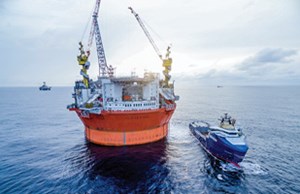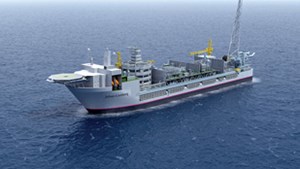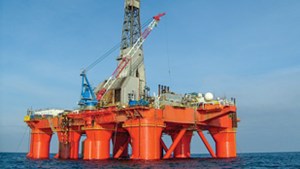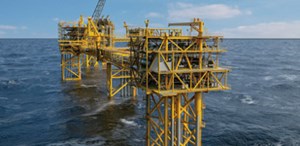Western Europe sees “positive development” offshore after years of output decline
Although global exploration has been fading of late, Western Europe’s offshore sector is still red-hot, in terms of E&P potential. According to a recent report from the Norwegian Petroleum Directorate (NPD), the Norwegian Continental Shelf (NCS), alone, still holds about 4 Bscme (141 Tcfe) of undiscovered resources. The report says that the region’s production is expected to increase; however, a number of new, very large finds must be uncovered, if the region expects to maintain its current level of output beyond the mid-2020s.

NORWAY
As Scandinavia’s richest economy, Norway continues to maintain its status as one of the world’s E&P leaders. “It [The NPD’s 2018 Resource Report] shows that after more than 50 years of activity, about 55% of anticipated oil and gas resources have yet to be produced. Of these, just under half have not even been discovered,” said NPD Exploration Director Torgeir Stordal in a release.
The NPD says that approximately two-thirds of the country’s vast, undiscovered resources lie in the Barents Sea, while the rest is distributed throughout the Norwegian and North Seas. More importantly, the 10 wildcat wells drilled during first-half 2018 already have found more new crude—a median estimate of 330 MMboe—offshore Norway than was found by 24 wildcats during all of 2017. “Prices are coming back up, so activity is picking up, and they’ll (operators) want to drill wells that they might have held back on when oil prices were low,” Stordal told Bloomberg. “It’s a positive development.”
Additionally, Stordal said that operators are becoming more likely to take risks, venturing further from the exploration areas surrounding established infrastructure. “It’s important to have a balanced approach to both prospects near infrastructure and frontier areas,” he explained. Overall, the NPD anticipates as many as 50 exploration wells in 2018, up from the 36 wells drilled last year.
Norwegian Sea. In the Haltenbanken area of the Norwegian Sea, Wintershall’s Maria field started producing in December, almost a year ahead of schedule. The development—situated about 12 mi east of Kristin field, and approximately 28 mi southwest of Heidrun field—is connected via subsea tie-backs to Equinor’s Kristin, Heidrun and Åsgard B production platforms. According to the company, this makes Maria one of the world’s most complex underwater projects.
The field’s tie-backs, in addition to a projected 25-year lifespan, reportedly could help prolong the production of surrounding fields, as well. Maria’s total recoverable reserves are estimated at approximately 180 MMboe, the majority of which are oil.
Faroe Petroleum reported recent progress at its Hades and Iris prospects, situated about 124 mi offshore in the Halten Terrace. In November, the Deepsea Bergen semisubmersible was commissioned to drill exploration well 6506/11–10, in the license area adjacent to Equinor’s producing Morvin and Åsgard fields. According to Faroe, the well targeted both the Cretaceous and Jurassic formations. The Hades Cretaceous prospect is a closure on the edge of the Sklinna Ridge, with the Iris Jurassic prospect positioned directly underneath.
Well results were announced in April, after significant shows were reported at both prospects. At 12,900 ft, the well encountered an almost 115-ft gas/condensate column within the Cretaceous Lange formation. Consequently, the Hades prospect was estimated to contain 19 MMboe to 113 MMboe of recoverable hydrocarbons.
Likewise, the Iris prospect uncovered an estimated 19 MMboe to 132 MMboe of recoverable hydrocarbons. At nearly 13,855 ft, the exploration well encountered a 715-ft high net-to-gross sandstone interval in the Jurassic Garn formation. Faroe said that, based on pressure data, the Hades and Iris prospects are separate hydrocarbon accumulations and that estimated resources for both prospects exceeded pre-drill estimates.
Faroe, alongside partner Aker BP, reported recent progress at Tambar field, as well. The satellite field saw the drilling of two new infill wells and the installation of gas lift in three existing wells during this past fall. The development program was aimed at increasing Tambar’s overall production. By the end of April, the two new wells had begun producing. The company said the initial flowrates reached 19,275 boed, exceeding pre-drill expectations.
According to Faroe, the installation of gas lift in three more existing wells is expected to take place during the third-quarter. The combination of infill wells and gas lift reportedly has the potential to substantively increase production at Tambar, as well as extend the field’s life by up to 10 years.
With oil prices now ranging between $60/bbl and $70/bbl, the region has begun its road to recovery. Accordingly, a number of important project developments are making headway as Plans for Development and Operation (PDOs) are submitted for approval.
In December, Faroe submitted its PDO for Fenja field, nearly 19 mi southwest of Equinor’s Njord field. It was approved by April. According to the company, the field development will consist of three horizontal production wells (one gas injector well and two water injector wells), which will be tied-back to the Njord A floating production facility. The operator, VNG Norge AS, reportedly estimates that the field holds gross recoverable resources of about 97 MMboe, 72% of which is said to be oil. It is anticipated to go onstream during first-quarter 2021, with a field life of 16 years.
Aker BP also submitted PDOs for three noteworthy projects—Valhall, Skogul and Ærfugl. Development of the Valhall western flank will involve an unmanned wellhead platform controlled from the field center. It will have 12 well slots, and the drilling of six new wells is planned. According to Aker BP, the development will increase the field’s reserves by approximately 60 MMbbl.
Although Skogul is one of the smallest fields on the Norwegian shelf, with reserves of about 9.4 MMbbl, it will require an estimated NOK 1.5 billion ($184 million) to develop. With a two-branch well drilled from a subsea template, and tied-in to Vilje field installations, Skogul will be connected to the pipeline from Vilje to Alvheim field. The Alvheim FPSO will process oil and gas from Skogul.
The Ærfugl development plan includes two phases, both of which are being developed with three independent satellite wells that will be tied-in to the Skarv FPSO. Phase One will involve the southern part of the Snadd deposit, while Phase Two will encompass the northern part, as well as Snadd Outer.
Repsol submitted a new PDO for Yme field in December, as well. The field—which is believed to hold approximately 65 MMbbl of recoverable oil—was formerly an actively producing oil field. However, it was deemed no longer profitable in 2001. It was subsequently abandoned. The new plan is to develop the field using existing facilities that had been installed after the approval of a 2007 redevelopment plan, which also resulted in abandonment, due to structural issues of the platform. Now, through utilization of the existing infrastructure, Yme field is scheduled for start-up in 2020.
Also in December, Equinor submitted a PDO for its Snorre expansion project, in the Tampen area of the Norwegian Sea. It is one of Equinor’s largest projects in terms of remaining reserves. According to the company, the lifespan of Snorre A was anticipated to last until 2011–2014. However, the expansion project—which includes 24 new wells (12 for production and 12 for injection); six new subsea templates for production and alternating water/gas injection; new pipelines and umbilicals, connecting the subsea templates and Snorre A; and a Snorre A upgrade—will extend its production life beyond 2040, producing an additional 200 MMbbl. Start-up is scheduled for 2021.
A PDO was submitted for Nova field (formerly known as Skarfjell) in May, situated about 12 mi southwest of the Gjøa platform. The field reportedly will be developed as a subsea tie-back, with two templates connecting to Gjøa. According to Wintershall (operator, 35%) and its partners, Nova field holds estimated recoverable reserves of approximately 80 MMboe, the bulk of which is oil. Start-up of the project is expected in 2021.
Key milestones were achieved this year at Equinor’s giant Johan Sverdrup field, almost 100 mi west of Stavanger. Phase One of the project has progressed steadily and, in September, it was reported that it was more than halfway complete. With estimated resources between 2.1 Bboe and 3.1 Bboe, Johan Sverdrup is one of the largest and most important industrial projects in Norway. The first phase of the project is expected to deliver estimated daily production of 440,000 bopd, once it is onstream. In early June, it was announced that the second of four platforms had been installed successfully (see cover photo). The remaining two topsides (the processing platform, and the utility and accommodation platform) are scheduled for installation in the spring of 2019. Phase One reportedly remains on track for first oil in late 2019.
Northwest of Johan Sverdrup, Equinor reported another oil discovery at Utsira High in June. The state-controlled company celebrated the Lille Prinsen wildcat find as its “first” discovery, since transitioning away from its former Statoil identity. According to a company news release, the discovery is expected to be commercial, amounting to an estimated 15 MMbbl to 35 MMbbl of recoverable oil. “This discovery has good quality and adds new volumes in an important area of the North Sea,” said Nicholas Ashton, senior V.P. of exploration, Norway & UK.

Barents Sea. Despite the vast amount of resources there, oil explorers have had a rough year in Norway’s Arctic. In addition to the lack of exploration success in the region, the country was, for the first time, forced to battle a lawsuit brought against it by activists claiming that the 10 exploration licenses awarded in 2016 breach the constitutional right to a healthy, productive and diverse environment. Additionally, activists claimed that the E&P activity conflicts with promises made under the 2015 Paris Agreement.
Nevertheless, industry leaders have been fighting back. “There are many forces who are using different venues to win over public opinion to the view that it’s not right to go ahead with new exploration and developments,” Petroleum and Energy Minister Terje Soviknes told Bloomberg. “There’s no reason why Norwegian oil and gas resources shouldn’t be competitive on the global market.”
Although it is widely underexplored, the Arctic is thought to hold the bulk of Norway’s resources and is seen as a potential solution to the North Sea output decline resulting from aging fields. As yet, the Eni-operated Goliat is the only producing oil field in the Barents Sea (Fig. 1), nearly 53 mi northwest of Hammerfest. It is believed to hold as much as 179 MMbbl of recoverable oil reserves.

In December, however, Equinor gave the green light to the $6-billion Johan Castberg project, about 93 mi from Goliat. “The project will be central in the further development of northern Norway, and create significant value and ripple effects,” said Margareth Ovrum, executive V.P. for technology, projects and drilling at Equinor. “We’re submitting a solid development plan for a field with halved investment costs that will be profitable with oil prices below $35/bbl.”
The Johan Castberg project’s resource base, which is estimated between 400 MMboe and 650 MMboe, stems from the Skrugard, Havis and Drivis discoveries in PL 532. According to Equinor, development of the field will consist of a production vessel and extensive subsea development with a total of 30 wells, 10 subsea templates and two satellite structures, making it the world’s largest subsea development, Fig. 2. Once developed, start-up of the large subsea field is scheduled for 2022. It is expected to carry a lifespan of 30 years.
UNITED KINGDOM
Despite recent setbacks—including economic uncertainty surrounding Brexit and the discovery of a crack in the Forties Pipeline System that disrupted the flow of production at more than 80 fields over several weeks—UK production has seen a sweeping resurgence. Following the pipeline’s reopening, regional output spiked 32% in January—the biggest monthly increase in more than a year, according to Bloomberg.
With several projects scheduled for start-up during 2018, UK output reportedly is expected to exceed last year’s average of 914,000 bopd by as much as 10%. The significant increase has many speculating as to whether the UK could soon become a net exporter.

There was a positive start to the year in terms of E&P activity in the area, as BP reported two new discoveries in Blocks 29/4e and 206/9b during January, Fig. 3. The Caipercaillie well was drilled to a TD of 12,303 ft, encountering light oil and gas-condensate in Paleocene and Cretaceous-age reservoirs. Likewise, the Achmelvich well was drilled to a TD of more than 7,857 ft, encountering oil in Mesozoic-age reservoirs. The company reported that the discoveries will now undergo evaluation, and well results will be assessed.
Also in January, Shell announced an FID for the redevelopment of Penguins field, approximately 150 mi northeast of the Shetland Islands. The field has four existing drill centers, which are tied back to the Brent Charlie platform. The redevelopment will see the drilling of eight additional wells that will be tied back to a new FPSO vessel.
In April, Apache Corp. reported a major discovery in the Garten prospect, nearly 4 mi south of the Beryl Alpha platform. The well reportedly was targeting a downthrown structural closure and encountered more than 700 ft of net oil pay in stacked, high-quality Jurassic-aged sandstone reservoirs. In a release, Apache President and CEO John Christmann IV said, “The Garten discovery marks our fourth commercial discovery in the Beryl area in the past three years, spanning several play types ranging from the Tertiary to the Triassic. Apache’s strategy to focus on exploration near operated facilities is set to deliver significant production without the long cycle time of large-scale projects.”
Fram field, more than 12 mi north of Troll field, was deemed uneconomical six years ago. However, Shell announced recently that it will now invest in the field’s development, with anticipated start-up of two producing wells by 2020. The wells reportedly will produce up to 13,000 boed, adding approximately 10% to the company’s current UK North Sea output. The oil major says it plans to connect Fram to its Shearwater processing facility.
DENMARK
Tyra field, Denmark’s crown jewel, continues to process 90% of the Nordic nation’s natural gas. The facilities have reached the end of their operational life, however, and a full redevelopment is required to extend its life and recover the field’s remaining resources.

In December, Maersk Oil was granted approval for its DKK 21-billion ($3.3-billion) investment in Tyra’s redevelopment, representing the largest oil and gas project investment ever made in the Danish North Sea. The redevelopment, which is scheduled to be completed in July 2022, will ensure that the country’s primary source for gas supply can continue operations for an another 25 years. According to the company, the field will be shut-in for the redevelopment in November 2019. Following its redevelopment, Tyra is expected to deliver about 60,000 boed at peak, Fig. 4.
Just three months after that announcement, A.P. Moller-Maersk announced its official exit from the Danish offshore oil industry, selling its energy unit to Total in an $8-billion deal. With the acquisition, Total received approximately 1 Bboe of 2P/2C reserves and resources—including those of Tyra field—making it the second-largest operator in the North Sea. ![]()


